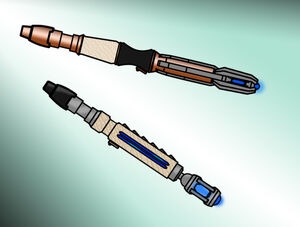
Two Models of Sonic Multi-tool
An entire toolkit in one, simple device, the Electromagnetic Multi-tool, produced by the Sonic Corporation, (Also known as the Sonic© EM Multi-tool, or just the Sonic Multi-tool) has been widely regarded as a must-have for smugglers, traders, and mechanics. The Sonic multi-tool was developed during the Clone Wars, and saw wide-spread use among the Imperial Military during the Galactic Civil War.
Due to the expensive nature of the device, it saw little use among the Rebel Alliance, and the few outdated models that made their way into the hands of Rebel pilots and mechanics were guarded more preciously than a smuggler's profit box.
Production History[]
Early Models[]
Initially launched shortly before the onset of the Clone Wars, the Sonic EM Multi-tool saw a number of developments over the course of it's first two years, with the Model 30 - widely acknowledged as the Model that truly established the tool as a must-have piece of equipment - coming into use in the final year of the wars, the year before the Galactic Republic was reformed into the Galactic Empire.
By the time of the Battle of Yavin, the Model 62 was the most advanced available, although it, along with many of the Series 5x Models, saw almost exclusive use in the hands of the Imperial Starfleet - the Rebellion, at this time, had access to very few of the tools, and usually only the outdated, Clone Wars era Series 3x models. Around three years later, every single Model 65 Sonic Multi-tool produced was supposedly shipped to the Forest Moon of Endor to equip the Engineers constructing the Second Death Star, and was thus, presumably, destroyed with the Battlestation during the Battle of Endor, making the Model 65 Multi-tool an extremely scarce model valued by collectors of rare antiquities in later years.

Various models of Sonic Multi-tool, spanning seventy years of popular usage.
A New Direction[]
Up until the Series 8x Models, all Sonic EM Multi-tools were built with an emitter that operated perpendicular to the shaft of the main tool. The Model 84, released in 17 ABY, introduced an adjustable head that could be rotated from it's default perpendicular angle to face straight from the shaft. This was later trialled as the standard positioning on the limited run Model 89, a multi-tool that was primarily a test bed for new technology, and would later be adopted as the only option on the Series 9x Multi-tools released two years later. The 9x series was also noteworthy for being the smallest and lightest of the Multi-tools, although they were also somewhat fragile compared to their larger cousins. Where as the manufacturers hoped the smaller design would make the tool more popular with hobbyists and technicians looking for portability, the fragility of the Series 9x Multi-tools, combined with the reduced functionality that the reduced size necessitated, ensured that even the final and most successful of the series, the Model 95, still saw weaker sales than Models 10 years older, and lead to the Model 89 being issued to combat-technicians during the Yuuzhan Vong War in stead of the Series 9x screwdrivers offered to the military at clearance prices. The Series 9x Multi-tools were short lived, as designers looked to recover losses made on the Series 9x Models by the early launch of the next Series.
The Series 10x line, launched with the Model 101, saw unprecedented success. Despite the obvious aesthetic and functional similarities to the 9x Series, the larger size and extra features introduced in the 101 made it both durable and more useful. The cream of the crop was definitely the 105, 106, and 107 Models, which were seen as the pinnacle of the Multi-tool, and proved so popular that they remained on sale as the top of the line models for almost twenty years - making this period, despite the slow-down in research and development of new models, the most successful for the Sonic Corporation's EM Multi-tool. During this time, many rival companies sought to muscle in on the energy-based Multi-tool action. Attempts met with varied success, but even Sonar Manufacturing's Multi-Tool came a pale second in most engineers' estimations, and the 'Laser' Multi-tool that was produced by the MastraCorp, which saw a temporary rush of success, was later deemed to be little more than a fad.
Perhaps one of the most prolific users of the 10x Series Sonic Multi-tool was not a famous engineer or designer, but Jedi Knight Dav Man'Sell, who purchased a newly launched Series 105 Multi-tool on Sernpidal just a few hours before it's destruction by the Yuuzhan Vong. Dav owned the Multi-tool for a number of years, still seen using it twenty-five years after his initial purchase of the device.

Jedi Master Ton Phedi, owner of the hugely successful Model 110 Sonic Multi-tool, and frequent "patient" of the Model 105.
Product Overhaul[]
After two decades in the limelight with the Series 10x, the Designers felt it was time for a new look. A second bold new design direction came about in the late 40s ABY with the launch of the 11x Series, which featured a larger-yet-sleeker, and more mechanical, aesthetic design with bolder styling. The 11x Series were the largest models seen since the aged 4x models released after the Clone Wars, but the design was seen as elegant and flattering, making the large size a non-issue. The 11x Series also featured new-technology, including a new version of the classic, twist orientated function control (a design element that hadn't been seen since the Series 5x Models), an all new concealed feed-back readout, and directional-amplification "prongs". These new features improved even upon the successful 10x Series, and were a very popular addition to the design, but were also more complex to use than the older designs. As a result of this, even after the launch of the Model 110, the Sonic Corporation continued to produce the 10x Series in limited quantities for those that preferred the older design. Both were utilised and popular, with the Model 110 being lauded for it's exciting new innovations and 'fun' design (which made it popular among the hobbyist and vessel modifiers that the 9x had sought to reach), and the 10x Series saw a series of special, after-market modification kits released in the years following the 110's launch, to allow the upgrade and enhancement of the older 105, 106, and 107 models which were still very popular within military-engineering circles. Perhaps most notably, in commemoration of the 25th anniversary of the launch of the 101, the Model 108 was launched as a limited edition special. It was note-worthy for adding some very noticeable extra elements to the older 10x designs, including a version of the directional-amplification "prongs" which was popularly known as the "red setting", due to the change of colour of the emitter that occurred when they were used.

A Model 100 Prototype Multitool.
Around the same time as the release of the 108, some of the 100 model Multi-tools - the non-production prototypes for the 10x line, which included a few settings that didn't make it into the production models until the later 105 model - became available for special purchase, and were bought up by both collectors and mechanics. One of these prototypes was purchased by an unknown buyer on Yavin Station in the year 49 ABY. The Model 100 prototypes were very rare, and fetched an impressive price even in poor condition - in later years, a flawless one would sell for the cost of a small Starfighter.
Design[]
The Sonic EM Multi-tool uses various degrees of Electromagnetic emissions from it's multi-purpose emitter, using everything from directional magnetic fields and static electric discharges, to light, heat, and even radio-waves, covering a wide range of the electromagnetic spectrum, and has fast become the most versatile and durable tool in the Galaxy. The EM fields emitted are used to manipulate the objects being worked on, providing it with a wide variety of uses.
The most popular models, the 105 and 106, featured a wide variety of functions, which included (but were not limited to):

Jedi Master Dav Man'Sell, famous for his legendary lightsaber skills, and his wide-spread use of the Model 105 Sonic Multi-tool, which he made famous.
- Magnetic Hydrospanner/servodriver
- Tuning Stylus
- Demagnetizer
- Plastfibe Agitator
- Finepoint Fusioncutter
- Lock Breaker
- Anti-adhesive energizer
- Glowrod
- Small-scale Magnetic Attractor
- Micro-probe
- Short-range flash heater/igniter stick
- Inciter
- Micrograbber/Micropoint
The sonic multi-tool, while common amongst the mechanic elite of the Galaxy, was once available for purchase on the now-dead planet of Sernpidal, and has seen expansive use by Jedi Master Dav Man'Sell, by whom it is said the sonic multi-tool has seen the most use, repairing fellow Jedi Tonaris Phedi's many cybernetic components.
Behind the Scenes[]
The Sonic Multi-tool is a tongue-in-cheek tribute to British Sci-Fi Doctor Who's Sonic Screwdriver. It was created, initially, for comic effect.